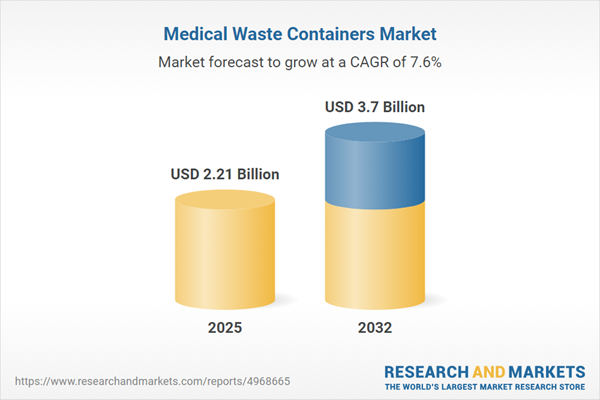Speak directly to the analyst to clarify any post sales queries you may have.
The medical waste containers market is evolving at pace, driven by shifting regulations, technological innovation, and rising sustainability priorities. Senior leaders in healthcare, life sciences, and waste management must assess containment strategies that ensure compliance, operational efficiency, and responsible environmental stewardship.
Market Snapshot: Medical Waste Containers Market Size and Growth
The Medical Waste Containers Market grew from USD 2.06 billion in 2024 to USD 2.21 billion in 2025 and is set to continue expanding at a CAGR of 7.57%, reaching USD 3.70 billion by 2032. This robust growth trajectory reflects heightened demand for compliant and innovative containment solutions across global healthcare and laboratory settings. As the sector faces evolving safety mandates and increasing awareness of ecological responsibilities, investment in advanced container systems is ascending across developed and emerging regions.
Scope and Segmentation Analysis
This report offers a comprehensive analysis of the medical waste containers market using clear segmentation and coverage of all core facets:
- Product Categories: Biohazard medical waste containers; Chemotherapy containers; Pharmaceutical waste containers; Resource Conservation & Recovery Act (RCRA) containers.
- Waste Types: General medical waste; Hazardous medical waste; Infectious medical waste; Radioactive medical waste; Sharps waste.
- Container Category: Disposable containers; Reusable containers.
- End Users: Academic research institutes; Diagnostic laboratories; Hospitals and private clinics; Pharmaceutical and biotechnology companies.
- Sales Channels: Offline; Online.
- Regional Coverage: Americas (North America: United States, Canada, Mexico; Latin America: Brazil, Argentina, Chile, Colombia, Peru); Europe, Middle East & Africa (Europe: United Kingdom, Germany, France, Russia, Italy, Spain, Netherlands, Sweden, Poland, Switzerland; Middle East: United Arab Emirates, Saudi Arabia, Qatar, Turkey, Israel; Africa: South Africa, Nigeria, Egypt, Kenya); Asia-Pacific (China, India, Japan, Australia, South Korea, Indonesia, Thailand, Malaysia, Singapore, Taiwan).
- Leading Companies Profiled: Aesculap, Inc.; Alleva Medical Ltd.; Becton, Dickinson, And Company; Bemis Manufacturing; Cardinal Health Inc.; Daniels Sharpsmart; Henry Schein, Inc.; Thermo Fisher Scientific, Inc., and others.
Key Takeaways: Strategic Insights for Decision-Makers
- Modern medical waste containers are integral to operational safety, providing frontline defense against pathogen exposure and underpinning infection control protocols throughout healthcare and laboratory environments.
- Stricter global regulations and harmonized standards have placed compliance at the center of procurement and management strategies, with organizations shifting towards systems designed to align with evolving legal frameworks.
- Technological advances—from smart sensor integration to modular, eco-friendly designs—are shaping both the functionality and sustainability profile of containment solutions while supporting robust segregation and streamlined waste handling processes.
- Supply chain resilience is increasingly vital; disruptions in raw material sourcing and international logistics have accelerated localization and collaborative procurement, reinforcing stability in container availability.
- Collaborative alliances between manufacturers, distributors, and waste management service providers are enabling end-to-end containment solutions that enhance customer value through bundled offerings, improved compliance, and lifecycle efficiency.
Tariff Impact: Navigating U.S. Tariff Adjustments
Recent changes to United States tariffs have increased cost pressures for manufacturers, especially those sourcing specialized polymers and finished containers internationally. Many suppliers are responding by boosting domestic production and reexamining sourcing strategies. In turn, this shift has prompted a greater focus on lifecycle costing, durability, and supply chain flexibility—factors now central to procurement and vendor selection in the medical waste containers market.
Methodology & Data Sources
This analysis combines rigorous secondary research with structured primary interviews. In-depth discussions with healthcare managers, waste experts, and manufacturers supplement comprehensive literature reviews and regulatory analysis. Key insights are validated through data triangulation, and verified performance data and case studies support recommendations.
Why This Report Matters
- Delivers nuanced intelligence on emerging containment technologies and regulatory shifts to improve procurement, compliance, and strategic planning.
- Enables targeted risk mitigation and value-driven decision-making by clarifying the operational, environmental, and cost impacts of evolving market forces, including tariff policies.
- Supports leadership teams in benchmarking best practices, harnessing global trends, and capturing region-specific opportunities in medical waste management.
Conclusion
This report provides senior executives with a clear view of market dynamics, regulatory direction, and strategic imperatives for medical waste containment. Leverage these insights to drive safety, sustainability, and operational excellence in your enterprise.
Additional Product Information:
- Purchase of this report includes 1 year online access with quarterly updates.
- This report can be updated on request. Please contact our Customer Experience team using the Ask a Question widget on our website.
Table of Contents
3. Executive Summary
4. Market Overview
7. Cumulative Impact of Artificial Intelligence 2025
Companies Mentioned
The companies profiled in this Medical Waste Containers market report include:- Aesculap, Inc. by B. Braun company
- Alleva Medical Ltd.
- Becton, Dickinson, And Company
- Bemis Manufacturing Company
- Biosigma S.p.A.
- Bondtech Corporation
- Bright Technologies Ltd.
- Cardinal Health Inc.
- COMECER S.p.A. by ATS Company
- Daniels Sharpsmart, Inc.
- DDC Dolphin Ltd
- ELITE BAGS, S.L.
- EnviroTain, LLC
- FL MEDICAL s.r.l.
- GPC Medical Ltd.
- Génia
- Henry Schein, Inc.
- MarketLab, Inc.
- MAUSER Group
- Medtronic PLC
- Milian SA
- Sharps Medical Waste Services
- Snyder Industries, Inc.
- Staples Professional Inc.
- Terra Universal, Inc.
- Thermo Fisher Scientific, Inc.
Table Information
| Report Attribute | Details |
|---|---|
| No. of Pages | 194 |
| Published | November 2025 |
| Forecast Period | 2025 - 2032 |
| Estimated Market Value ( USD | $ 2.21 Billion |
| Forecasted Market Value ( USD | $ 3.7 Billion |
| Compound Annual Growth Rate | 7.5% |
| Regions Covered | Global |
| No. of Companies Mentioned | 27 |









